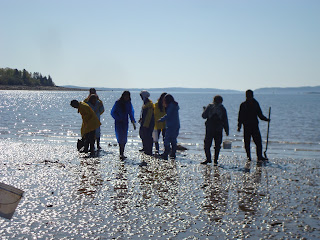Grade 11 and 12 students from Eastview Secondary School, who arrived late Sunday afternoon, have been enjoying a busy week here at the Huntsman. The students began their week with an introduction to the local marine invertebrates, then a tour of the Fundy Discovery Aquarium as well as a field trip to Indian Point to study a mixed seashore environment.
On Tuesday and Wednesday morning the students were divided into two groups and while some hopped aboard the Fundy Spray to collect data and specimen samples, the others were in the lab learning more about the important, yet microscopic organisms, plankton. Students in the lab also were introduced to some of the invasive species found in this area as well. In the afternoon, on Tuesday, students and staff went to Pottery Creek to capture, mark and release one of the better known invasive species in this area, the Green Crab. Also while there the students took the opportunity to study the marine worms. Tuesday evening was spent back in the lab identifying and classifying marine algae. On Wednesday afternoon experiments in echinoderm behaviour were conducted, as well the students were given the opportunity to take a tour of the Atlantic Reference Centre.
If you look under the rocks and seaweed at Pottery Creek you are sure to find some Green Crabs.
This crab will be marked on the back of its' shell and then released.
Trying to identify the worms dug up can be hard work.
This student is not phased by the large clam worm she is holding.
Dig!
Who knew seaweed was this much fun?
I think this particular 'algae' is giving the boys some trouble, maybe those girls can help.
Plankton Bingo takes sharp eyes.
Here is a planktonic polychaete specimen under the microscope.
The Fundy Spray.
Disembarking the Fundy Spray after a trip to collect specimens.
How fast can your urchin flip?
This experiment is testing the strength of the echinoderm's tube feet.



























































